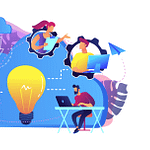Nearly six million people in the UK work from home regularly.
While the COVID-19 pandemic gave the remote work movement a si gnificant jumpstart, the reason the trend has continued (and will likely grow in the coming years) has to do largely with Software-as-a-Service or SaaS solutions.
What is SaaS, and why is it so crucial to work-from-home success? Find the answers to these questions and learn how SaaS is revolutionising the future of remote work below.
SaaS Basics
SaaS is an application delivery method that relies on the internet. Rather than installing software on individual devices, users can access it as long as they have an internet connection.
The global SaaS market is valued at $333.03 billion, and it’s expected to reach a valuation of $819.23 billion by 2030. Much of this increase in value will likely come from a rise in software solutions used by remote and hybrid workers.
Remote Work and the Engagement Gap
Remote work has delivered many benefits to employees worldwide, from healthcare workers who can now see patients remotely to telemarketers who can make phone calls without ever setting foot in an office.
At the same time, though, there are also downsides to the growing popularity of remote work, specifically when it comes to employee engagement.
Employee engagement refers to employees’ involvement and enthusiasm in their workplace and their work. Because remote workers do not share a common workplace, many struggle to feel the same level of involvement and enthusiasm that they did when they worked in a more traditional office setting.
In the long run, poor employee engagement rates can be detrimental to a company’s success. After all, if employees are not involved and enthusiastic, they’re unlikely to be putting their best foot forward and providing high-quality work. They’re also unlikely to be good ambassadors to the company brand, which can make it more difficult to recruit top-tier talent in the future.
The following are some examples of how remote work can interfere with high employee engagement levels.
- Information gets lost in translation because emplyees are communicating via various channels (rather than just stopping by someone’s office to deliver a message).
- Employer/manager/supervisor communications have minimal reach and effectiveness because employees don’t receive the message, receive the message too late, don’t understand the message, etc.
- Employees lack opportunities to connect with colleagues, which can create a sense of loneliness that interferes with productivity and performance.
- Employers/managers/supervisors struggle to gather feedback, meaning they continue to make the same mistakes and don’t understand why/how employees are struggling to remain engaged.
How SaaS Can Boost Employee Engagement
Software-as-a-Service tools have the potential to bridge the remote work engagement gap and help employees, regardless of where they’re located, develop stronger relationships with their colleagues, become more enthusiastic and involved at work, and reignite their commitment to delivering quality work.
Here are some specific examples of how the right SaaS tools can boost employee engagement:
SaaS Tools Prevent Misunderstandings and Conflict
Employees can’t be engaged when they can’t communicate and collaborate effectively. SaaS solves this problem in a few different ways.
First, SaaS centralises communication. It allows employees to communicate through one platform, rather than jumping between texts, emails, chat messages, etc. — the more jumping you do, the easier it is for things to get misconstrued and for conflict to arise.
SaaS also helps employees work together instead of side by side.
In other words, instead of every person working on their own tasks and checking in once a week during a team meeting, colleagues can collaborate and communicate through a shared platform. This approach allows them to bounce ideas off each other, solve problems more quickly, and address concerns as soon as they arise.
SaaS Tools Allow for More Frequent Feedback
Many SaaS tools, especially those dedicated to employee engagement, include survey features that allow employees to share feedback related to their work experience, progress they’re making toward their goals, potential concerns or complaints, etc.
When they implement an employee engagement software solution, employers can gather information from employees more frequently and gain a more holistic understanding of how they’re doing, what’s working, and where there’s room for improvement.
Simply having the option to share feedback, alone, can be empowering to employees.
If they know that someone wants to know about their experience, they will likely feel more appreciated. Feeling more appreciated, in turn, can lead to improved performance, increased commitment to projects, and better quality work.
SaaS Tools Create Opportunities for Employee Recognition
In addition to providing tools for employees to deliver feedback, SaaS solutions also give employers, managers, supervisors, and other leads opportunities for employee recognition.
It doesn’t matter if someone wants to send a team member a private message letting them know they appreciate their hard work or they want to shout someone out to the whole group. SaaS platforms make it easier for team leaders to do all these things.
An increase in employee recognition, like an increase in requests for feedback, can empower employees and encourage them to continue doing good work moving forward. Being recognised can also help to combat feelings of loneliness that often show up among remote workers.
How Can You Use SaaS to Drive Remote Work Transformations?
Many businesses and remote teams are already using SaaS solutions successfully, and their dependence on these powerful tools will only increase over time.
Here are some examples of how SaaS companies can help organisations increase engagement, productivity, performance, and more:
- Chat Apps for Improved Communication: Chat apps make it easy for team members to communicate back and forth, share documents, schedule meetings, and more.
- Kanban Boards for Better Project Management: Many apps use Kanban boards to help employees efficiently organise tasks based on their current status (e.g., “to-do,” “doing,” “done,” etc.).
- Encryption Tools for Increased Security: Encryption software solutions allow employees to work from anywhere and on various devices without sacrificing the company’s security.
- Video Apps for More Efficient Meetings: Video apps make meetings more engaging, allow employees to stay in the loop, and create more opportunities for collaboration.
Conclusion
It doesn’t matter if you’re an employee who wants to make your remote work easier or a manager who wants to empower team members to get more done from home.
Either way, software as a service technology can play a critical role in helping you accomplish your goals and enhance workplace engagement.
Keep the examples and advice shared above in mind so you can adopt the right technological solutions for you and your colleagues.
Author: Dan Martell – Founder & CEO, SaaS Academy
Photo credit: Gary Barnes




